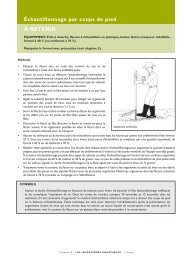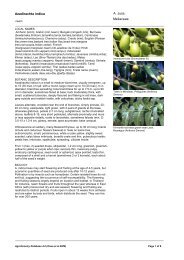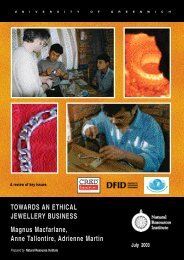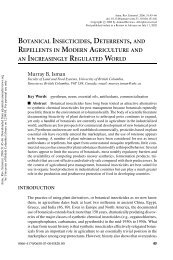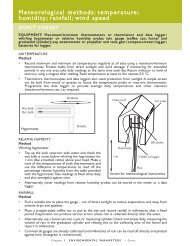African Water Laws - Natural Resources Institute
African Water Laws - Natural Resources Institute
African Water Laws - Natural Resources Institute
Create successful ePaper yourself
Turn your PDF publications into a flip-book with our unique Google optimized e-Paper software.
SHAH<br />
were, in principle, considered for giving away leases but there was a pecking order of priority: first priority was<br />
for a Below Poverty Line family, then to a local poor fisherman, then to a local co-operative, and if none of<br />
these were available, then to any entrepreneur who bid in an open auction. Earlier, the government paid a puny<br />
rental to the Gram Panchayats for using them for fish culture; now that entrepreneurs were allowed, Gram<br />
Panchayats began setting an off-set price derived as an estimate of the ‘fishing value’ of the tank, which was<br />
20-30 times the rental Panchayats received earlier from the Department. Even so, as soon as leases were open<br />
to entrepreneurs, many came forward. A later change in policy gave co-operatives some discount in the ‘upset<br />
price’ and other benefits. In 2003, a series of new changes in the policy framework gave further fillip to<br />
productivity growth: the lease period was extended from 3 years to 10 years, which reduced the contractors’<br />
gullibility to changes in Panchayat leadership and also made investment in productivity enhancement<br />
attractive. The new policy also removed the last vestiges of special treatment to co-ops, and provided for a<br />
public auction of the lease after open advertisement.<br />
During 1971-1998, inland fishery output of Gujarat increased six-fold from 14000 mt in 1971 to over 80,000<br />
mt in 1998-99 (Govt of Gujarat 2004). Considering that Gujarat hardly had any culture fishery before 1950, it<br />
must be said that the credit for this growth rightly belongs to the government’s efforts. Government invested in<br />
subsidies, organizing inputs, bringing in new technology, extension and training and much else. All these<br />
played a role in expanding the fisheries economy. However, perhaps, the most important impact has been<br />
produced by two factors: [a] the changes made at the margins in the leasing policies of water bodies that have<br />
shaped the transaction costs of setting up and operating a profitable culture fishery business; and [b] the high<br />
costs of controlling poaching, which has ensured that besides several entrepreneurial qualities, successful<br />
fishing contractors also have to acquire and deploy muscle power.<br />
Several less sensational examples can be offered of spontaneous institutions that operate on a large scale to<br />
fulfill needs to serve which water establishments promote copybook institutions. I briefly mentioned earlier<br />
how hundreds of defunct community RO or defluoridation plants set up by governments to supply fluoride-free<br />
drinking water to village communities have failed under community management. However, in North Gujarat,<br />
as a demand curve has emerged for fluoride-free drinking water, some 300 plants selling packed water have<br />
mushroomed in the cottage sector; over half of these were set up after 2001, mostly in mofussil towns to serve<br />
permanent customers as well as retail water in polythene pouches. 20 The RO cottage industry of Gujarat was<br />
quietly serving a growing demand when the ‘IE’ caught up with it. In 2001, the Bureau of Indian standards<br />
made it compulsory for cottage RO plants to get ISI mark. This entailed that each plant had to invest Rs 0.3-0.4<br />
million in an in-house laboratory and pay an annual certification fee of Rs 84,000. This single move put paid to<br />
the emerging RO water cottage industry; 200 operators had to close their businesses because the new<br />
announcement doubled their cost of production. Yet, setting up an in-house laboratory and paying annual<br />
certification fee implied no guarantee of quality assurance because BIS inspectors hardly visit plants if ever.<br />
Many customers Indu (2001) interviewed wondered if the ISI mark—like AGMARK ghee and honey—can by<br />
itself guarantee quality unless BIS itself put its act together in the first place.<br />
Likewise, many state governments are struggling, in vein, to cut their losses from operating mostly World Bank<br />
funded public tubewell programs by trying to transfer these to idealized co-operatives. If the purpose of a cooperative<br />
tubewell is to enable a group of farmers to mobilize capital, to install and operate a tubewell for<br />
mutual benefit of members, such tubewell groups have existed for decades in North Gujarat. The difference is<br />
that, having been created to serve the purpose of their members, their ownership structure and operating rules<br />
are designed to minimize the transaction costs of cooperating on a sustained basis (Shah and Banerjee 1998).<br />
The Government of Gujarat tried hard to transfer its public tubewells to idealized co-operatives, but thanks to<br />
the very high transaction costs relative to the pay-off facing potential entrepreneurs, the program made no<br />
headway until 1998 when the terms of turn over were rewritten. 21 Basically, the requirement that a co-operative<br />
be registered under the Co-operative Act was dropped; the lease period was extended from 1 to five years; and<br />
changes were introduced which made it possible for one or few major stake holders to assume the role of<br />
tubewell manager and residual claimant. These minor changes suddenly gave a fillip to the program, and over a<br />
3 year period, over half of Gujarat’s public tubewells, some 3500 in all, were transferred to farmer groups. An<br />
IWMI-Tata study of turned over public tubewells (Mukherji and Kishore 2003) showed that within a year after<br />
2-13



